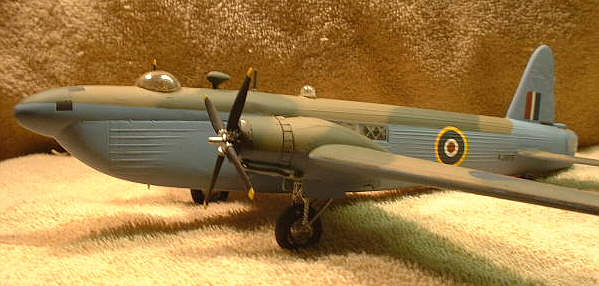
The a/c was developed during WW2 as a high altitude medium bomger, it saw very limited service.
It had a fukky pressurized crew compartment. The Unicraft Conversion has 2 forward fuselage halves , a
bubble canopy & a sheet of clear palstic for the 4 nose windows in the fuselage. I also got the
Novo/Frog Wellington mk IX kit with the conversion.
|

The conversion is fairly straight forward. The kit nose must be removed a 1/4 inch back from the wing
recess on the kit. I then mated the new forward fuselage to the remaining kit fuselage, to line them up right.
The fuselage windows had to be shortened about a 1/4 inch. I made a simple pilots stationup front a
floor out of sheet plastic & used the kit seat, control column & instrument panel, don't get too fancy as
much of it cannot be seen through the small bubble canopy. The Novo kit is a bear to build,
but the kit is over 30 years old. The right wing was warped way out of kilter, I wound up cutting it outside
the engine nacelle & then glueing it together. Be prepared to use a lot of putty on the kit seams & where the new nose joins the fuselage.
|

After the kit was finally sanded & primed, I used Extra-color paints, British Green & Brown for the top & Sky Type-s
for the bottom. I used the few photos & drawings in Squadrons Wellington in action for reference. The kit needs 4-bladed props,
it so happened that the ones from the Airfix P-61 matched up perfectly, also the ends of the exhausts need to be cut & turned
into the nacelle for the supercharger to work Decals were used from the scrap box, there was no squadron codes on the a/c just
the national insignia & the Registration number. Overall this is a great conversion of one of British rather unknown bombers.
Even though there is a lot of work to be done, that's what modelling is all about.
|





